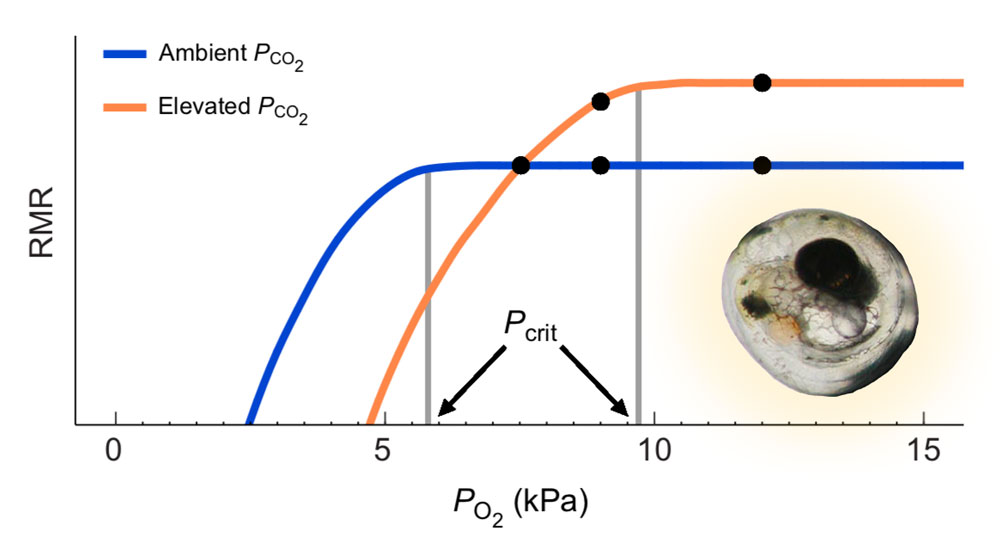
- Schwemmer, T.S., Baumann, H., Murray, C.S., Molina, A.I., and Nye, J. (2020) Synergistic metabolic responses of embryos, but not larvae, of a coastal forage fish to acidification and hypoxia. Journal of Experimental Biology 223:jeb228015

27 July 2020. Big and proud congratulations to Chris Murray, who published his last big chunk of data from his PhD research on the effects of marine climate change on coastal marine fish. The publication in PLOS One synthesized 3 years of multiple, long-term experiments on Atlantic silversides (Menidia menidia) demonstrating consistent negative growth effects on high CO2 conditions. However, sometimes it takes more than just looking at means and standard deviations to elucidate these effects. Hence, in this paper, shift functions analyzing the different percentiles of distributions are employed.
Murray, C.S. and Baumann, H. (2020) Are long-term growth responses to elevated pCO2 sex-specific in fish? PLOS One 15:e0235817
The publication was featured in UConn Today “UConn Research: More Carbon in the Ocean Can Lead to Smaller Fish”
By Elaina Hancock
As humans continue to send large quantities of carbon into the atmosphere, much of that carbon is absorbed by the ocean, and UConn researchers have found high CO2 concentrations in water can make fish grow smaller.
Researchers Christopher Murray PhD ’19, now at the University of Washington, and UConn Associate Professor of Marine Sciences Hannes Baumann have published their findings in the Public Library of Science (PLoS One).
“The ocean takes up quite a bit of CO2. Estimates are that it takes up about one-third to one-half of all CO2 emissions to date,” says Murray. “It does a fantastic job of buffering the atmosphere but the consequence is ocean acidification.”
Life relies on chemical reactions and even a slight change in pH can impede the normal physiological functions of some marine organisms; therefore, the ocean’s buffering effect may be good for land-dwellers, but not so good for ocean inhabitants.
Baumann explains that in the study of ocean acidification (or OA), researchers have tended to assume fish are too mobile and tolerant of heightened CO2 levels to be adversely impacted.
“Fish are really active, robust animals with fantastic acid/base regulatory capacity,” says Murray. “So when OA was emerging as a major ocean stressor, the assumption was that fish are going to be OK, [since] they are not like bivalves or sea urchins or some of the other animals showing early sensitivities.”
The research needed for drawing such conclusions requires long-term studies that measure potential differences between test conditions. With fish, this is no easy task, says Baumann, largely due to logistical difficulties in rearing fish in laboratory settings.
“For instance, many previous experiments may not have seen the adverse effects on fish growth, because they incidentally have given fish larvae too much food. This is often done to keep these fragile little larvae alive, but the problem is that fish may eat their way out of trouble — they overcompensate – so you come away from your experiment thinking that fish growth is no different under future ocean conditions,” says Baumann.
In other words, if fish are consuming more calories because their bodies are working harder to cope with stressors like high CO2 levels, a large food ration would mask any growth deficits.
Additionally, previous studies that concluded fish are not impacted by high CO2 levels involved long-lived species of commercial interest. Baumann and Murray overcame this hurdle by using a small, shorter-lived fish called the Atlantic silverside so they could study the fish across its life cycle. They conducted several independent experiments over the course of three years. The fish were reared under controlled conditions from the moment the eggs were fertilized until they were about 4 months old to see if there were cumulative effects of living in higher CO2 conditions.
Murray explains, “We tested two CO2 levels, present-day levels and the maximum level of CO2 we would see in the ocean in 300 years under a worst-case emissions scenario. The caveat to that is that silversides spawn and develop as larvae and early juveniles in coastal systems that are prone to biochemical swings in CO2 and therefore the fish are well-adapted to these swings.”
The maximum CO2 level applied in the experiments is one aspect that makes this research novel, says Murray,
“That is another important difference between our study and other studies that focus on long-term effects; almost all studies to date have used a lower CO2 level that corresponds with predictions for the global ocean at the end of this century, while we applied this maximum level. So it is not surprising that other studies that used longer-lived animals during relatively short durations have not really found any effects. We used levels that are relevant for the environment where our experimental species actually occurs.”
Baumann and Murray hypothesized that there would be small, yet cumulative, effects to measure. They also expected fish living in sub-ideal temperatures would experience more stress related to the high CO2 concentrations and that female fish would experience the greatest growth deficits.
The researchers also used the opportunity to study if there were sex-determination impacts on the population in the varying CO2 conditions. Sex-determination in Atlantic silversides depends on temperature, but the influence of seawater pH is unknown. In some freshwater fish, low pH conditions produce more males in the population. However, they did not find any evidence of the high CO2 levels impacting sex differentiation in the population. And the growth males and females appeared to be equally affected by high CO2.
“What we found is a pretty consistent response in that if you rear these fish under ideal conditions and feed them pretty controlled amounts of food, not over-feeding them, high CO2 conditions do reduce their growth in measurable amounts,” says Murray.
They found a growth deficit of between five and ten percent, which Murray says amounts to only a few millimeters overall, but the results are consistent. The fish living at less ideal temperatures and more CO2 experienced greater reductions in growth.
Murray concludes that by addressing potential shortcomings of previous studies, the data are clear: “Previous studies have probably underestimated the effects on fish growth. What our paper is demonstrating is that indeed if you expose these fish to high CO2 for a significant part of their life cycle, there is a measurable reduction in their growth. This is the most important finding of the paper.”
This work was funded by the National Science Foundation grant number OCE #1536165. You can follow the researchers on Twitter @baumannlab1 and @CMurray187.

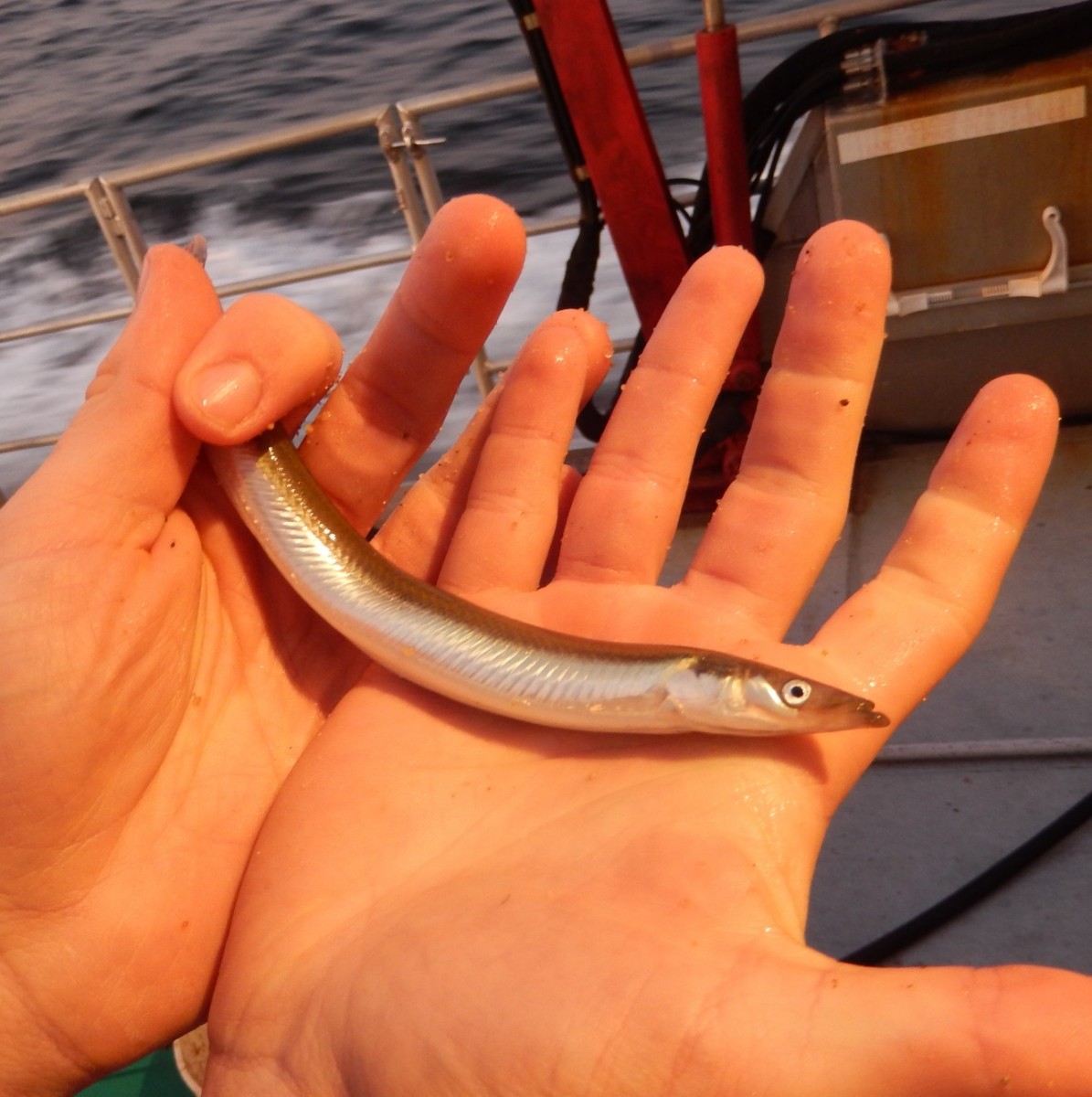
The publication of this article was featured by UConn Today on 24 March 2020.
This work represents the first comprehensive assessment of this important forage fish in the Northwest Atlantic, though similar efforts have been carried out in the Pacific Northwest and Europe. In the Atlantic, sand lance are observed to be a significant food source for the federally endangered Roseate tern, Atlantic sturgeon and cod, Harbor and Grey seals and Minke and Humpback whales. “This paper is a call to our peers and colleagues that there is a big gap in knowledge, and to bring more attention to these species as unmanaged forage fish,” says Staudinger.
Staudinger, M., Goyert, H., Suca, J., Coleman, K., Welch, L., Llopiz, J., Wiley, D., Altman, I., Applegate, A., Auster, P., Baumann, H., Beaty, J., Boelke, D., Kaufman, L., Loring, P., Moxley, J., Paton, S., Powers, K., Richardson, D.E., Robbins, J., Runge, J., Smith, B.E., Spiegel, C., and Steinmetz, H. (2020)
The role of sand lances (Ammodytes sp.) in the Northwest Atlantic Ecosystem: a synthesis of current knowledge with implications for conservation and management
Fish and Fisheries (published online 20 March 2020)
Pringle, J.W. and Baumann, H. (2019) Otolith-based growth reconstructions in young-of-year Atlantic silversides (Menidia menidia) and their implications for sex-selective survival. Marine Ecology Progress Series 632:193-204

“We examined the utility of otolith microstructure analysis in young-of-year (YoY) Atlantic silversides Menidia menidia, an important annual forage fish species along the North American Atlantic coast. We first compared the known hatch window of a local population (Long Island Sound, USA) to otolith-derived hatch distributions, finding that YoY collected in October were reliably aged whereas survivors from November and December were progressively under- aged, likely due to the onset of winter ring formation. In all collections, males outnumbered fe- males, and both sexes had bimodal size distributions. However, while small and large females were almost evenly represented (~60 and ~40%, respectively), over 94% of all males belonged to the small size group. We then examined increment widths as proxies for somatic growth, which suggested that bimodal size distributions resulted from 2 distinct slow- and fast-growing YoY phe- notypes. Length back-calculations of October YoY confirmed this, because fast- and slow-growing phenotypes arose within common bi-weekly hatch intervals. We concluded that the partial sexual size dimorphism in this population resulted largely from sex-specific growth differences and not primarily from earlier female than male hatch dates, as predicted by the well-studied phenome- non of temperature-dependent sex determination (TSD) in this species. Furthermore, observed sex ratios were considerably less male-biased than reconstructed thermal histories and published laboratory TSD values predicted. Assuming that selective mortality is generally biased against slower growing individuals, this process would predominantly remove male silversides from the population and explain the more balanced sex ratios at the end of the growing season.”
“The equilibrium state of the ocean-atmosphere system has been perturbed these last few decades with the ocean becoming a source of oxygen for the atmosphere even though its oxygen inventory is only ~0.6% of that of the atmosphere. Different analyses conclude that the global ocean oxygen content has decreased by 1-2% since the middle of the 20th century. Global warming is expected to have contributed to this decrease, directly because the solubility of oxygen in warmer waters decreases, and indirectly through changes in the physical and biogeochemical dynamics.”
Access the full report from IUCN.org
Chapter 6. Multiple stressors – forces that combine to worsen deoxygenation and its effects.
In: Ocean deoxygenation: everyone’s problem. Causes, impacts, consequences and solutions
International Union for Conservation of Nature (IUCN). Report xxii, 562p.
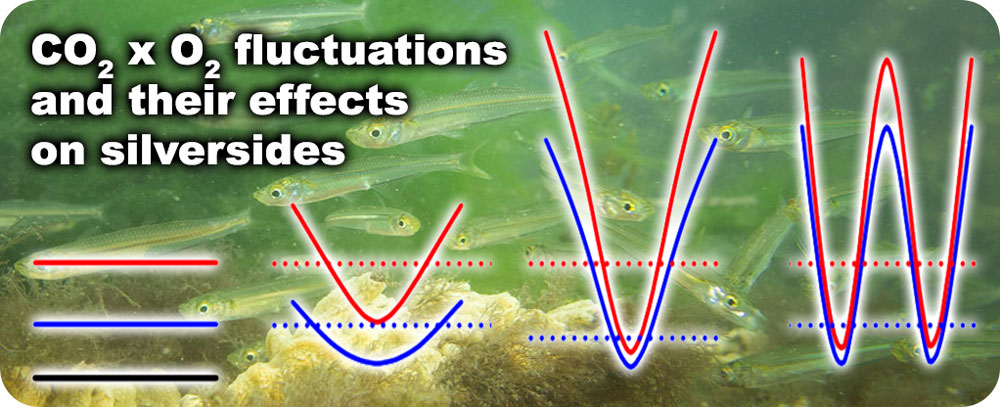
3 December 2019. We are happy and proud to share that Scientific Reports has published our latest research on the effects of fluctuating CO2 × O2 environments on the early life stages of Atlantic Silversides. The paper synthesizes findings of two years and four separate experiments – all conducted in our automated larval fish rearing system – to answer the question how current and future diel and tidal fluctuations in CO2 and O2 affect the survival and growth of silverside embryos and larvae.
The paper is a great demonstration of the vast capabilities of our system to simulate non-static conditions, which is a frontier in climate change research. Congrats to Emma Cross for pulling all the complex data together!



From the Abstract:
“Static low DO conditions severely decreased embryo survival, larval survival, time to 50% hatch, size at hatch and post-larval growth rates. Static elevated pco2 did not affect most response traits, however, a synergistic negative effect did occur on embryo survival under hypoxic conditions (3.0 mg L−1). Cycling CO2 × DO, however, reduced these negative effects of static conditions on all response traits with the magnitude of fluctuations influencing the extent of this reduction. This indicates that fluctuations in pco2 and DO may benefit coastal organisms by providing periodic physiological refuge from stressful conditions, which could promote species adaptability to climate change.”
The source data for this publication are openly available (and citable) from the BCO-DMO database. Head to Products -> Research Data to access them!
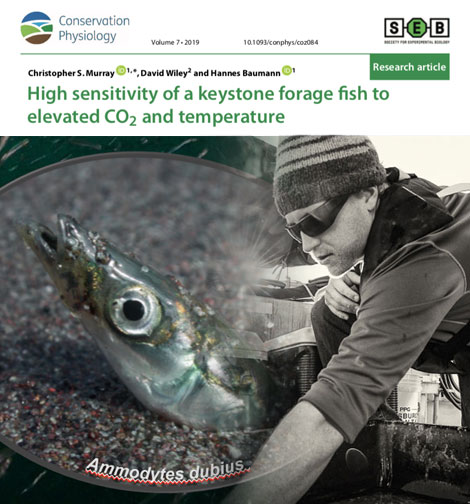
Indeed, given the observed effect sizes, northern sand lance might be the most CO2 sensitive fish species tested to date.
High sensitivity of a keystone forage fish to elevated CO2 and temperature
Conservation Physiology 7:1-12
Thanks to the more than 50 people who attended the webinar. If you have missed it, it’s accessible for free online. See below.
Therkildsen, N.O., Wilder, A.P., Conover, D.O., Munch, S.B., Baumann, H., and Palumbi, S.R. (2019)
Contrasting genomic shifts underlie parallel phenotypic evolution in response to fishing
Science 365:487-490
Related perspective: Fishing for answers Science 365: 443-444 | Cornell Press release | UConn Press release
Now, for the first time, researchers have unraveled genome-wide changes that prompted by fisheries – changes that previously had been invisible, according to a study published in Science by a team of researchers including Hannes Baumann, UConn assistant professor of Marine Sciences, who collaborated with researchers at Cornell University, the University of Oregon, the National Marine Fisheries Service, and Stanford University.
In unprecedented detail, the study shows sweeping genetic changes and how quickly those changes occur in fish populations extensively harvested by humans, says Baumann.
“Most people think of evolution as a very slow process that unfolds over millennial time scales, but evolution can, in fact, happen very quickly,” said lead author Nina Overgaard Therkildsen, Cornell assistant professor of conservation genomics in the Department of Natural Resources.
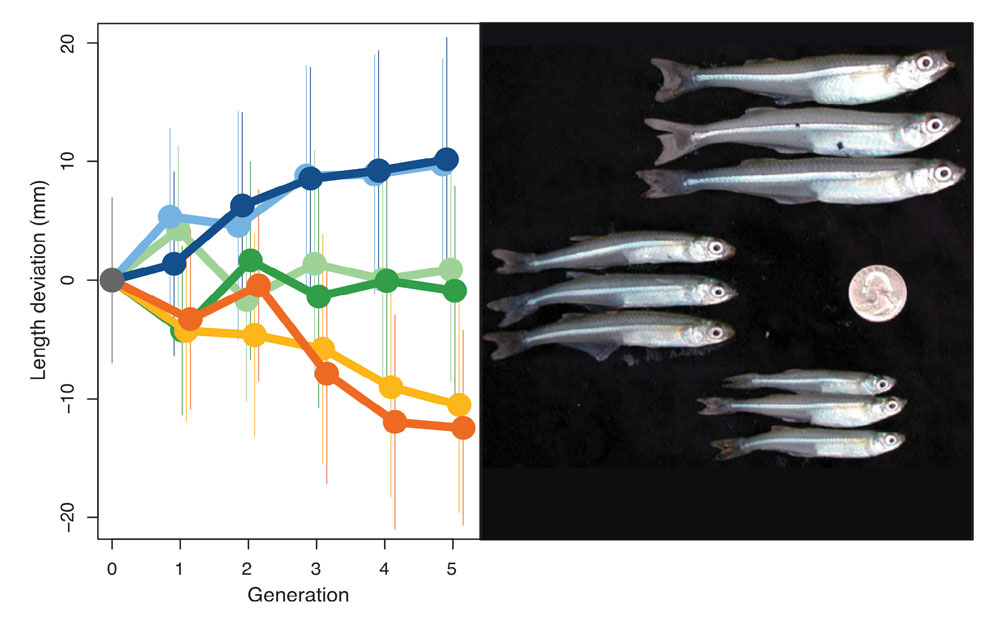
The all-pervasive human meddling in our planet’s affairs undeniably reached the genetic make-up of its organisms.
— Hannes Baumann, UConn.
In heavily exploited fish stocks, fishing almost always targets the largest individuals. “Slower-growing fish will be smaller and escape the nets better, thereby having a higher chance of passing their genes on to the next generations. This way, fishing can cause rapid evolutionary change in growth rates and other traits,” said Therkildsen. “We see many indications of this effect in wild fish stocks, but no one has known what the underlying genetic changes were.”
Therkildsen and her colleagues took advantage of an influential experiment published back in 2002. Six populations of Atlantic silversides, a fish that grows no bigger than 6 inches in length, had been subjected to intense harvesting in the lab. In two populations, the largest individuals were removed; in another two populations, the smallest individuals were removed; and in the final two populations, the fishing was random with respect to size.
After only four generations, these different harvest regimes had led to evolution of an almost two-fold difference in adult size between the groups. Therkildsen and her team sequenced the full genome of almost 900 of these fish to examine the DNA-level changes responsible for these striking shifts.
The team identified hundreds of different genes across the genome that changed consistently between populations selected for fast and slow growth. They also observed large linked-blocks of genes that changed in concert, dramatically shifting the frequencies of hundreds of genes all at the same time.
Surprisingly, these large shifts only happened in some of the populations, according to the new paper. This means that there were multiple genomic solutions for the fish in this experiment to get either larger or smaller.
“Some of these changes are easier to reverse than others, so to predict the impacts of fisheries-induced evolution, it is not enough to track growth rates alone, we need to monitor changes at the genomic level,” said Therkildsen.
When the experiment was originally conducted nearly two decades ago by co-authors David Conover, professor of biology at the University of Oregon, and Stephan Munch of the National Marine Fisheries Service, the tools to study the genomic basis of the rapid fisheries-induced evolution they observed were not available. Fortunately, Conover and Munch had the foresight to store the samples in a freezer, making it possible to now return – armed with modern DNA sequencing tools – and reveal the underlying genomic shifts.
Research like this can assess human impacts, and improve humanity’s understanding of “the speed, consequences and reversibility of complex adaptations as we continue to sculpt the evolutionary trajectories of the species around us,” Therkildsen said.
“What’s most fascinating about this is that life can find different genetic ways to achieve the same result. In this study, two experimental populations evolved smaller body size in response to the selective removal of the largest fish, which is what most trawl fisheries do. However, only by looking at the genetic level we demonstrated that these two experimental populations evolved via two completely different genetic paths,” says Baumann.
The good news for the Atlantic silversides is that the fisheries selection was able to tap into the large reservoir of genetic variation that exists across the natural range of this species from Florida into Canada, said Therkildsen: “That genetic bank fueled rapid adaptation in the face of strong fishing pressure. Similar responses may occur in response to climate-induced shifts in other species with large genetic variability.”
“Scientists have coined the term Anthropocene in recognition of the all-pervasive human alteration of the earth’s climate, oceans, and land. No matter how ‘pristine’ a piece of nature may look to us at first glance, examine it thoroughly enough and you will find a trace of human in it. Take a cup of water from the middle of Pacific Ocean and a handful of sand from a ‘pristine’ beach – and you will find little plastic particles under the microscope,” says Baumann. “The parallel to this study is that the all-pervasive human meddling in our planet’s affairs now undeniably reached the genetic make-up of its organisms. Today’s fishes may superficially look the same as always, but their genes are not. They bear witness to human alteration.”
In addition to Baumann, Therkildsen, Conover, and Munch, co-authors included former Cornell postdoctoral researcher Aryn P. Wilder, now a researcher at San Diego Zoo Institute for Conservation Research; and Stephen R. Palumbi, Stanford University.
This work was funded by the National Science Foundation.

The event featured two keynote speakers; Professor Margaret Rubega of UConn, and Professor Tim Cronin of MIT. Professor Rubega talked about science communication and how the scientific community could better communicate their climate change research to non-scientists without using overbearing jargon and too many words. Professor Cronin gave a speech on his past research on the suppression of Arctic air formation with climate warming.